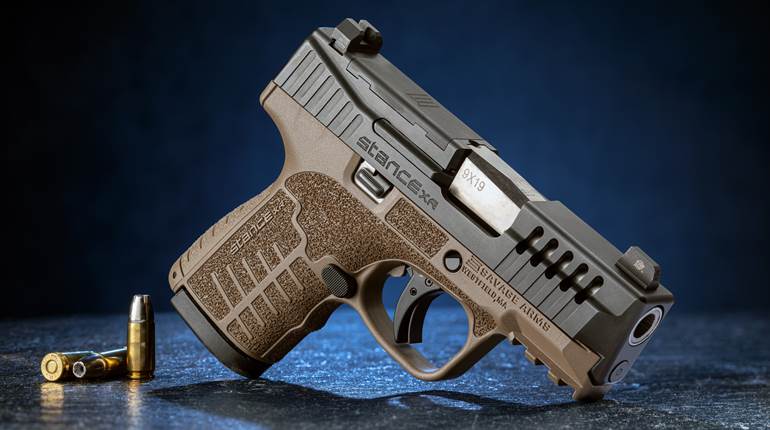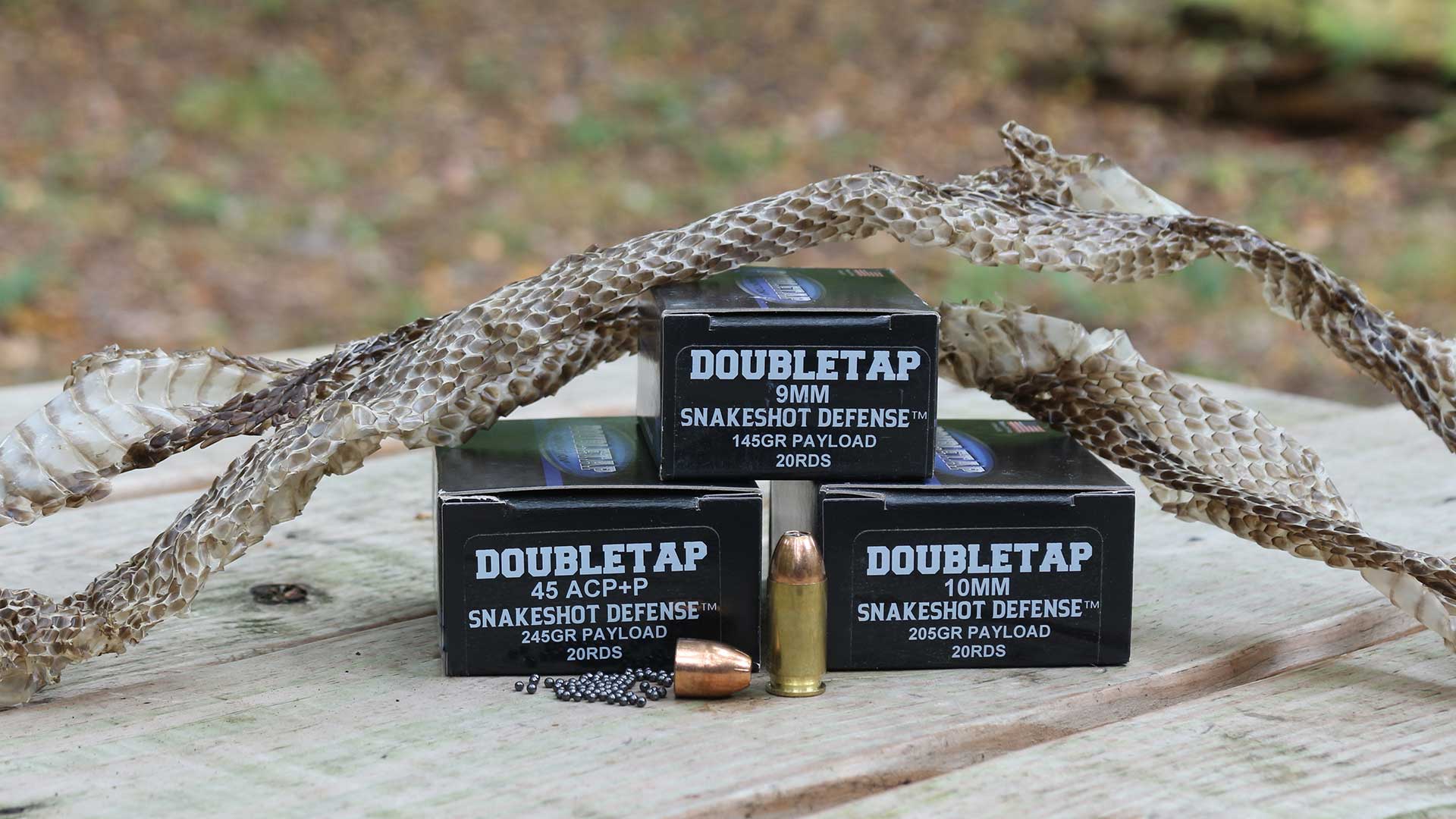
Israel Weapon Industries’ (IWI) Tavor has proven itself to be one of the most successful bullpup rifles offered on the civilian market. In 2018, the company announced that it would be augmenting its 5.56 NATO, .300 Blackout and 9 mm Luger models with a version in 7.62 NATO (the Israelis took a similar track with its original battle rifle, the Galil, complementing the smaller-caliber original with a larger-caliber sibling). The .30-cal. Tavor not only adds a harder-hitting chambering to IWI’s bullpup lineup, it builds on the experience gained with the original Tavor rifles, resulting in a highly refined and original design in its own right.
Designated the Tavor 7, the 7.62 mm bullpup mixes the features of both IWI’s SAR and X95 rifles. A magazine release button in the “AR-15” position above the trigger is mirrored on both sides of the rifle, in addition to a left-side release above the magazine. A safety lever is also located on both sides above the grip and moves through an arc of 45 degrees. The bolt release is positioned behind the magazine. Also, the Tavor 7’s non-reciprocating charging handle can be locked to the rear in a notch to hold the bolt open; the rifle can then be charged “H&K style” once a loaded magazine is inserted. The charging handle can be swapped to either side to complete a fully ambidextrous package.
The Tavor 7 uses an SR-25-pattern magazine and comes supplied with a Magpul LR/SR 20-round detachable box. Its 16.5" chrome-lined, cold-hammer-forged barrel is free-floated in the rifle’s polymer chassis, and the muzzle is threaded 5/8x24 TPI. A 20" barrel conversion kit is available from IWI for $529. Two QD swivel sockets, as well as a hook-type sling attachment point, are featured on each side of the rifle. The Tavor 7 comes supplied with two QD swivels.
The rifle’s handguard features M-Lok slots for attaching accessories. The lower portion, which includes a built-in hand stop, slides off to reveal a 3.5" section of M1913 Picatinny rail on the 6-o’clock position. The Tavor 7 comes supplied with a cutlass-style grip with a large, full-hand trigger guard. Compatible with the X95, a grip unit with a more traditional, single-finger trigger guard is available as an accessory.
Under a rigid polymer body, the Tavor 7 uses a machined hard-anodized aluminum receiver (just like the other rifles in the Tavor lineup) that the bolt carrier group rides in and into which a steel barrel extension is fitted. The barrel is locked to the extension using the same system as the X95 and can be removed with a barrel wrench. Where the Tavor 7 differs from the rest of the Tavor lineup is its operating system.
Unlike the 5.56 NATO and .300 Blackout carbines, the Tavor 7 uses a short-stroke gas piston. While the “small-frame” Tavors use a gas piston attached to the bolt carrier, the Tavor 7 uses a separate gas piston that acts upon the bolt carrier. The Tavor 7 has an adjustable gas regulator with four positions: regular for normal firing; “adverse” for when the rifle is dirty or in a cold climate; “suppressed” to limit backpressure when using a suppressor; and “off,” which disables the gas system and allows the rifle to function as a manually operated repeater. The bullet on a 7.62 NATO cartridge can be used to adjust the regulator.

At 28.5" overall, the bullpup configuration of the Tavor 7 comes in nearly 10" shorter than a conventional semi-automatic 7.62 NATO rifle with a barrel of similar length, such as the Springfield M1A SOCOM 16. The rifle, with an empty magazine in place and no sights, tips the scales at 9 lbs., 13 ozs.—about two pounds more than the 5.56 NATO Tavor X95 models. Unlike the X95, the Tavor 7 does not come equipped with iron sights. Instead a 14.75" section of hard-anodized aluminum M1913 Picatinny rail allows for the attachment of iron sights or optics. For range testing, we mounted a Leupold Patrol 1-6X low-power variable optic that complements the Tavor 7’s ability to perform at both close and extended ranges.
The Tavor 7’s trigger has two distinctive stages and is very good by bullpup standards. The second stage breaks at just over 5 lbs. after a slight take-up, and it has a distinct reset point. Recoil is pleasantly mild due to several factors. First, our rifle as tested, with scope, mount and fully loaded magazine, was pushing 12 lbs. Other factors that helped tame recoil are the generous surface area of the hard polymer buttplate, the rifle’s straight-line design and a highly efficient muzzle brake.
While the rifle produced several sub-1.5" groups at 100 yards, it averaged between 2 and 3 m.o.a. with the ammunition we tested. The rifle functioned flawlessly with every type of ammunition we tried, including some past-its-prime, yet appropriate, Israeli surplus. The Tavor 7 can be disassembled using only a cartridge or a punch. Removing a pushpin allows the buttplate to be hinged open so that the bolt assembly can be removed to the rear. The gas piston is twisted to the release position and removed forward. Though not necessary for normal cleaning, the rifle’s fire control unit is secured by pushpins and easily removable.
Due to the proximity of the ejection port to the shooter’s face, the Tavor must be specifically configured to a right- or left-handed shooter; unlike earlier Tavor designs, this process is quick, straightforward and requires no extra conversion parts. The ejection direction can be changed by moving the charging handle, appropriately repositioning the ejection port cover/case deflector and removing the bolt-carrier group and rotating its bolt head 75 degrees—a process that can be completed in about two minutes.
The Tavor 7 is available in black, flat dark earth or OD green. While the .30-cal. Tavor’s trigger unit is not compatible with aftermarket units designed for the 5.56 NATO Tavors, most other accessories made for the original Tavor lineup, such as handguards, are offered for use in the Tavor 7 from IWI and other aftermarket manufacturers.
IWI’s Tavor 7 is a rugged, compact and reasonably accurate semi-automatic rifle in a heavy-hitting cartridge, making it appropriate for uses as varied as big-game hunting to self-defense. The company’s award-winning bullpup rifles now have a distinctive big brother.





































